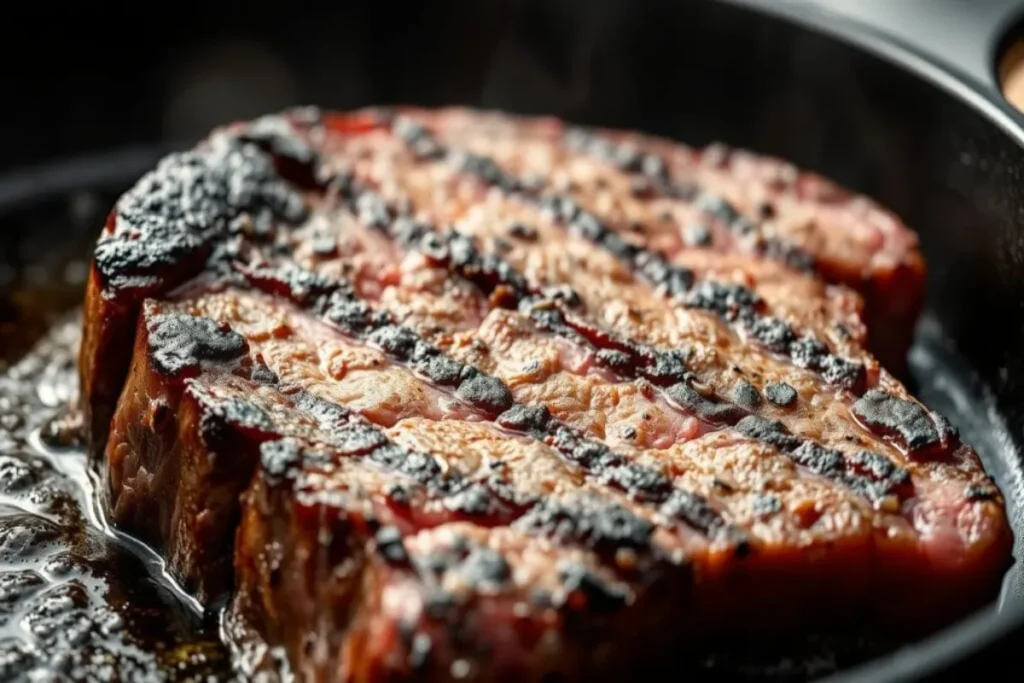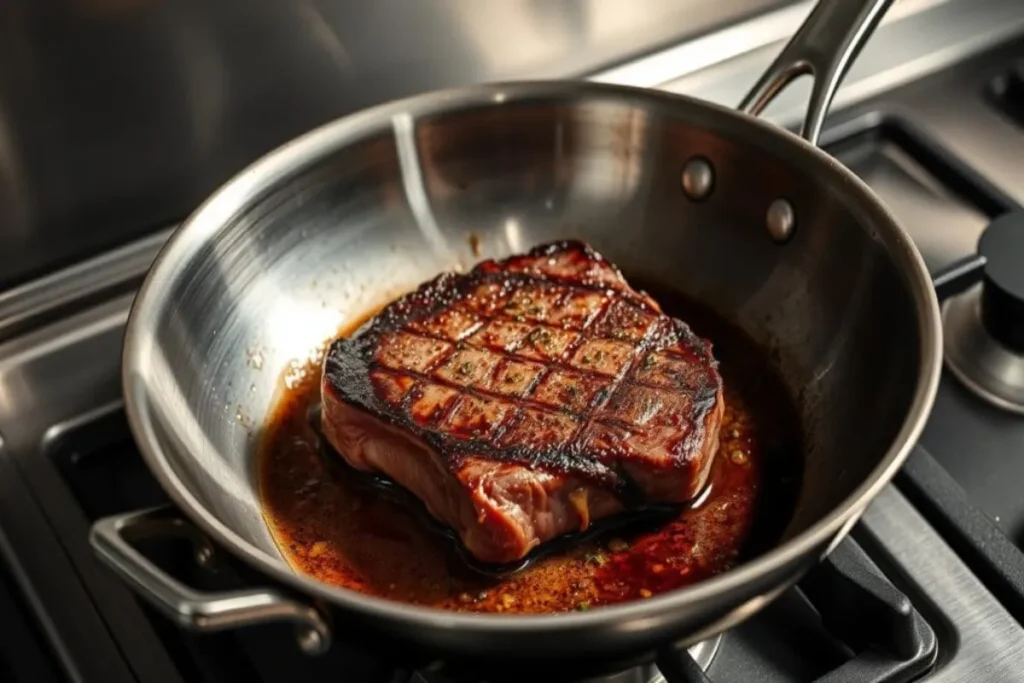Ever had a bite of a perfectly seared steak? and What Does It Mean to Be Seared? crispy outside and tender inside are amazing. This is thanks to a cooking technique called searing. It makes food taste better and feel more special.
Searing uses heat and time to create amazing flavors and textures. As we learn more about searing, you’ll see how it can make your cooking better. It turns simple meals into something truly special.
Table of Contents
The Art of Searing in Cooking
The art of searing is a key technique that turns simple ingredients into amazing dishes. It creates a flavorful crust while keeping the inside moist. This makes your food stand out, bringing joy to chefs and home cooks.
Learning to sear well shows you how it works with other cooking methods like braising and roasting. High heat triggers the Maillard reaction, which brings out new flavors. Getting the timing and heat right is key to perfect searing.
Mastering searing requires skill and knowing how ingredients react to heat. Using the right cookware, like a heavy-bottomed pan, helps distribute heat evenly. This prevents steaming and ensures a good sear. Becoming good at searing can greatly improve your dishes’ taste and look, showing off your cooking skills.
What does it mean to be seared?
Searing is a cooking method that uses high heat to create a tasty crust on food. It’s often used for meats and veggies, making them taste great with little effort. Knowing what searing is shows its big role in cooking.
Definition of Searing
Searing happens at temperatures between 400°F to 500°F (204°C to 260°C). This heat makes the food’s surface brown quickly. This seals in moisture, making the food juicier.
A well-seared steak can keep up to 20% more moisture than an unseared one. Without proper searing, you might lose 15-30% of flavor and juiciness. This shows why learning to sear is key.
Scientific Explanation
The science behind searing is the Maillard reaction. It’s a complex process that happens when food heats up. This reaction brings out rich flavors and aromas, making your dishes better.
For the best searing, cook for 2-3 minutes on each side. Scanpan cookware can reach these temperatures fast, saving up to 30% of cooking time.
Understanding the Searing Technique
The seared technique is key in cooking, boosting flavors and textures of meats like pork, poultry, and beef. It’s a two-step process starting on the stovetop and ending in the oven. Knowing how to sear well is essential for a perfect crust and juicy inside.
Temperature control is critical in searing. A hot pan is needed for a flavorful browned coating. Olive oil helps in even browning, ensuring flavor consistency. Avoid moving the meat too much to get that perfect caramelized crust.
Choose larger meat cuts for better searing. Smaller pieces cook too fast, leading to uneven results. Also, overcrowding the pan can cause steaming instead of searing, affecting flavor and texture.
After searing, let the meat rest. This step helps keep juices in and improves the dish’s quality. For fish like salmon, manage the searing carefully. Start with a cold, dry pan for even cooking and crisp skin.
In summary, mastering the seared technique can transform proteins and sugars through the Maillard reaction. It boosts your cooking skills and enhances the dining experience.
How Searing Affects Flavor and Texture

Searing is more than just a cooking method; it changes food’s flavor and texture. The Maillard reaction is key to this change. It happens when amino acids and sugars react to high heat, creating new compounds.
These compounds give seared meats their unique taste and smell. The result is a crispy outside and a juicy inside.
Maillard Reaction and Its Importance
The Maillard reaction is vital for flavor in searing. It makes meat taste rich and complex, unlike boiling or steaming. Both traditional and reverse searing use this reaction to create unique flavors.
In traditional searing, high heat quickly browns the meat. Reverse searing starts with low heat, then finishes with a high-heat sear. This enhances the texture.
Contrast Between Sear and Other Cooking Methods
When comparing seared vs grilled, both use high heat but differ in results. Grilling gives a charred taste from direct flame. Searing creates a crust that keeps moisture in, whether on the stovetop or in the oven.
Unlike boiling, which can make food taste bland and soggy, searing locks in flavor. It ensures a juicy, satisfying bite.
Common Foods That Are Seared
Searing is a popular cooking method used for meats and some vegetables. It creates a unique flavor and texture. Pork, poultry, and beef are common foods that benefit from searing. This technique makes them taste better.
When searing, it’s important to know how ingredients react to heat. Start by heating a pan on the stovetop. Use olive oil for even browning. A hot pan is key for a good sear.
Vegetables like asparagus and bell peppers also benefit from searing. They get a caramelized texture and keep their flavors. This method is great for larger pieces of vegetables.
A table shows some popular seared dishes:
| Food Item | Type | Recommended Cooking Time | Ideal Cooking Method |
|---|---|---|---|
| Ribeye Steak | Seared Meat | 2-3 minutes per side | Stovetop, finish in oven |
| Pork Chops | Seared Meat | 2-3 minutes per side | Stovetop, finish in oven |
| Chicken Breast | Seared Meat | 2-3 minutes per side | Stovetop, finish in oven |
| Asparagus | Seared Vegetables | 3-5 minutes | Stovetop |
| Bell Peppers | Seared Vegetables | 3-5 minutes | Stovetop |
In conclusion, searing can make your cooking better. Whether it’s meat or vegetables, the right techniques and environment matter. Popular seared dishes offer deeper flavors that are a joy to eat.
How to Achieve a Perfect Sear

To master the art of searing, focus on the right cut of meat and the tools you use. A perfect sear boosts flavor and keeps meat juicy. This makes your dish tender and delicious.
Choosing the Right Cut of Meat
Choosing the right meat is key for a great crust. Opt for ribeye or New York strip for their marbling and thickness. The steak should be at least 1.5 inches thick for the best results.
This thickness ensures a medium-rare doneness without overcooking. It’s best to cook two steaks, each weighing 12 ounces.
Essential Tools for Searing
The right tools make a big difference in searing. Use an oven-safe skillet or pan, avoiding those with rubber or plastic handles. A meat thermometer is vital for accurate internal temperature checks.
A high-quality pan like Scanpan is great for searing. It heats up quickly due to its thermal conductivity.
Here is a concise overview of necessary tools and their features:
| Tool | Description |
|---|---|
| Oven-Safe Skillet | Durable cookware that withstands high heat for effective searing. |
| Meat Thermometer | Ensures precise measurement of internal temperatures for perfect doneness. |
| High Smoke Point Oil | Provides a great sear without burning. |
| Butter | Adds flavor through basting during the cooking process. |
By following these tips, you’ll get a perfect sear every time. Preparing the right meat and using the right tools will make your meals unforgettable.
Seared vs Grilled: What’s the Difference?
Looking into searing and grilling shows they have their own special qualities. The main difference is how they cook and the tastes they bring out.
Searing happens on the stovetop. It focuses on getting the meat close to the hot pan for a tasty crust. Grilling, on the other hand, uses direct heat from below. It adds a smoky taste to food through flames. Both ways make food taste and feel different.
When comparing cooking methods, searing might not cook evenly, like with T-bone steaks. The T-shaped bone can lift the steak from the pan. Grilling is better for T-bone steaks because it lets you control the heat. This helps cook the meat parts at different rates.
Choosing between searing and grilling depends on what you want. If you want a caramelized crust, searing is the way. For a smoky taste and juicy meat, grilling is the better choice.
| Feature | Searing | Grilling |
|---|---|---|
| Heat Source | Stovetop | Direct Heat (Grill) |
| Flavor Profile | Caramelized Crust | Smoky Flavor |
| Contact | Maximum Contact with Pan | Cooked Above Heat Source |
| Best Uses | Steaks, Fish | Steaks, Vegetables, Burgers |
Examples of Seared Dishes
Searing makes food taste better and look great. Popular dishes include steak, pork chops, and chicken breasts. They get a golden crust, keeping juices in and flavors intense. Learning to sear means you can make tasty meals anytime.
Popular Seared Meat Recipes
Getting a perfect sear on meat takes skill and timing. For example, a medium steak is best removed from the oven at about 130 degrees Fahrenheit. This ensures it reaches 135 degrees for serving. Chicken breasts need 5-10 minutes in the oven after browning on the stovetop, based on thickness.
The recommended cooking temperature for finishing meat is 400 degrees Fahrenheit. Always let your cooked meat rest before serving. Individual portions should rest for about 5 minutes.
Seared Vegetables and Their Benefits
Searing isn’t just for meat; it’s great for vegetables too. Mushrooms, bell peppers, and zucchini get a lot of flavor from searing. It caramelizes their sugars, making them taste amazing and feel great in your mouth.
Searing vegetables adds a smoky taste, making any meal better. It also helps you try new things in your diet.
Conclusion
Searing is a key technique in cooking that boosts flavor and texture. It creates a beautiful crust and starts the Maillard reaction, making food taste better. Learning about searing is essential for anyone who wants to be a great cook.
When you start using searing techniques, you’ll see how it can make simple ingredients into amazing dishes. This knowledge will help you make your meals more enjoyable. Searing is not just cooking; it’s an art that lets you be creative in the kitchen.
Mastering searing will take your cooking to the next level. You’ll be able to impress everyone with your dishes’ rich flavors and great looks. So, go ahead and practice searing in your kitchen. It will be a big part of your cooking journey.
For more delicious recipes and kitchen inspiration, stick around and explore our other articles.

